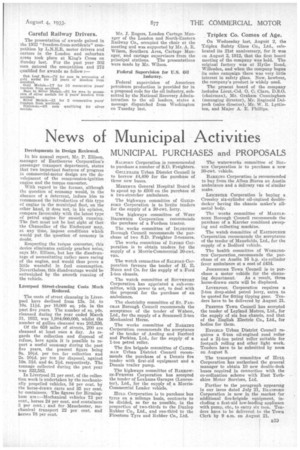News of Municipal Activities
Page 29

If you've noticed an error in this article please click here to report it so we can fix it.
Developments in Design Reviewed.
In his annual report, Mr. P. Ellison, manager of Eastbourne Corporation's passenger transport department, states that two important features of progress in commercial-motor design are the development of the compression-ignition engine and the torque converter.
With regard to the former, although the question of economy would, in the absence of a deterrent, induce him to recommend the introduction of this type of engine in the municipal fleet, on the other hand, it does not, in his opinion, compare favourably with the latest type of petrol engine for smooth running. The fact must not be lost sight of that the Chancellor of the Exchequer may, at any time, impose conditions which would put the question of economy in doubt.
Respecting the torque converter, this device eliminates entirely gearbox noise, says Mr. Ellison, but has the disadvantage of necessitating rather more racing of the engine, and would thus prove a little wasteful in fuel consumption. Nevertheless, this disadvantage would be outweighed by the smooth running of the vehicle.
Liverpool street-cleansing Costs Much Reduced.
The costs of street cleansing in Liverpool have declined from 13s. 3d. to 10s. 11id. per 10,000 sq. yds. in the past five years. The number of sq. yds. cleansed during the year ended March 31. 1933, was 1,984,000,000, whilst the number of gullies cleansed was 203,336.
Of the 658 miles of streets, 200 are cleansed at least once a day. As regards the collection and disposal of refuse, here again it is possible to report a useful economy during the past five years, the present figure being Os. 100. per ton for collection and 2s. 100, per ton for disposal, against 10s. 3*d. and 4s. 2hd. respectively. The tonnage collected during the past year was 322,582.
In Liverpool 31 per cent. of the collection work is undertaken by the mechanicfilly propelled vehicles, 34 per cent, by the horse-drawn carts and 35 per cent. by containers. The figures for Birmingham are :—Mechanical vehicles 73 per cent., horses 24 per cent. and containers :; per cent. ; and for Manchester, mechanical transport 22 per cent, and horses 78 per cent.




















































































